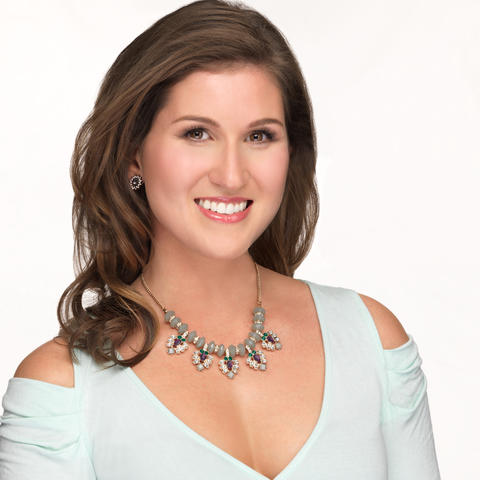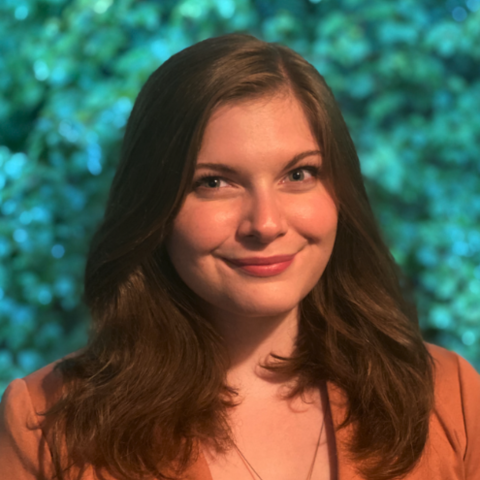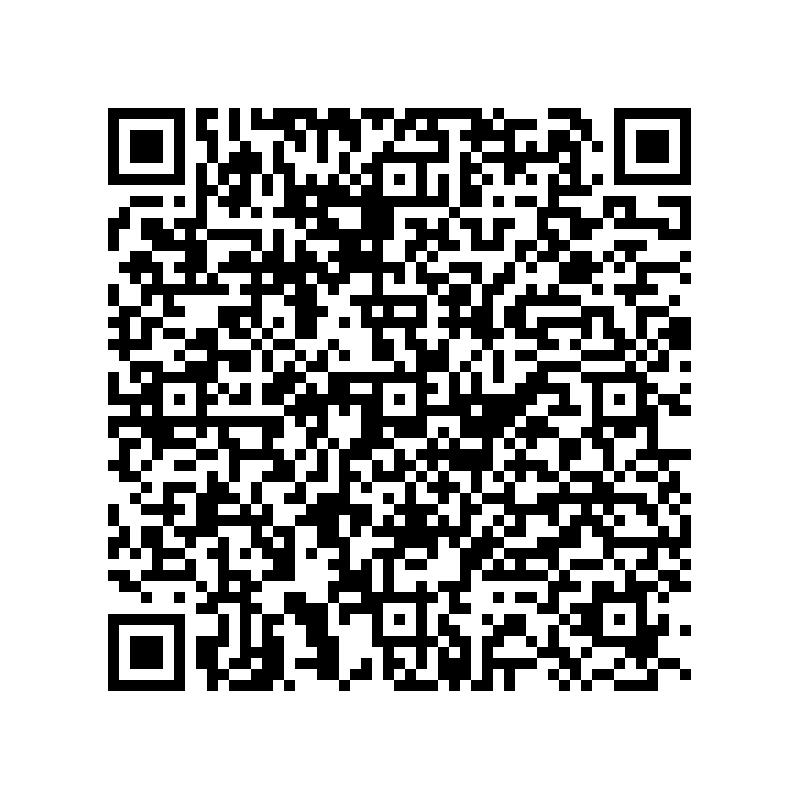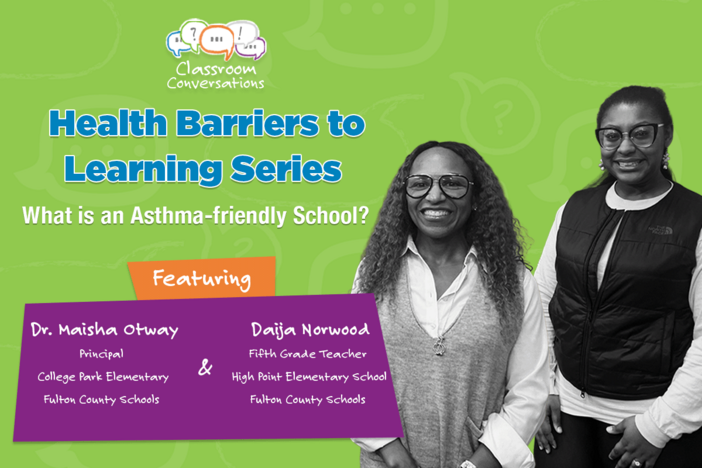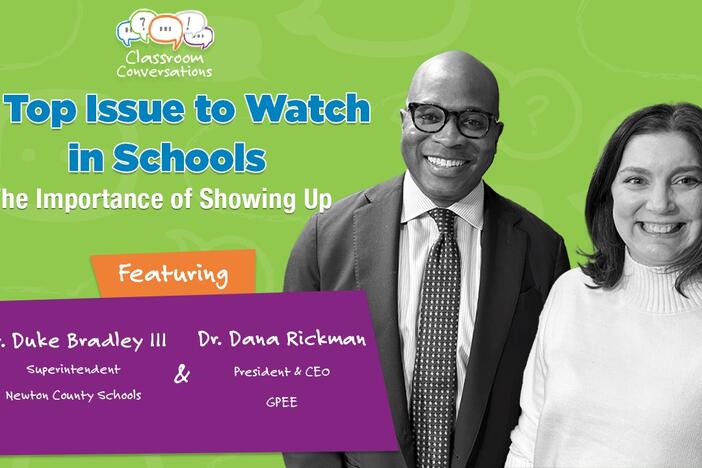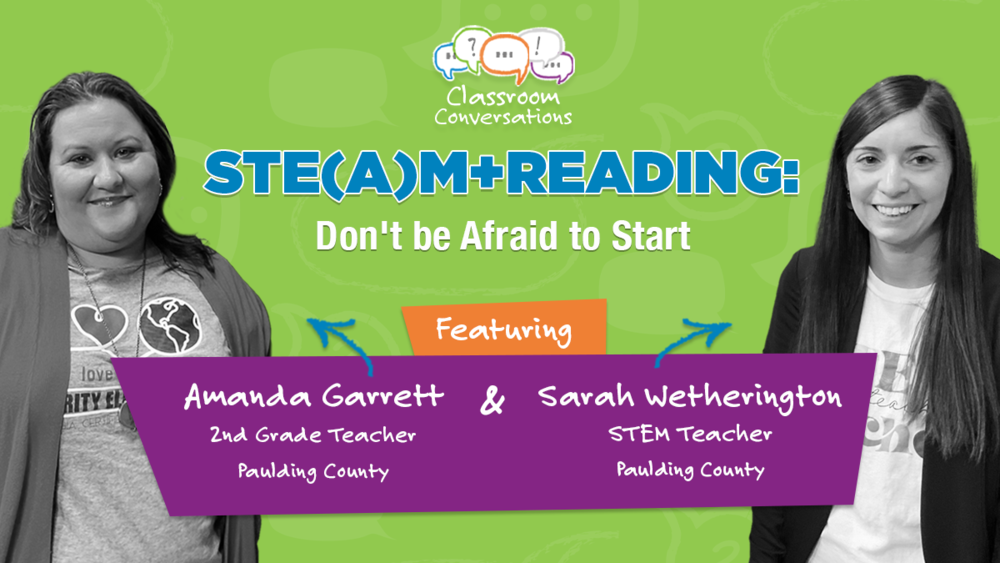
Section Branding
Header Content
Episode 316: STE(A)M+READING: Don't be Afraid to Start
Primary Content
How can we use STE(A)M principles in our classrooms to encourage student curiosity and collaboration? Join us in conversation with Amanda Garrett and Sarah Wetherington of Paulding County for our Season 3 finale! Thanks for listening! We'll be back soon with Season 4!

How can we use STE(A)M principles in our classrooms to encourage student curiosity and collaboration? Join us in conversation with Amanda Garrett and Sarah Wetherington of Paulding County for our Season 3 finale!
Click here to watch this episode on YouTube.
TRANSCRIPT
Ashley Mengwasser: Hey, Georgia educators. We have new discussion guides available to use with Classroom Conversations episodes. These discussion guides include open-ended questions to facilitate great discussion and professional learning. After listening to each podcast, find the new discussion guides posted with the Classroom Conversations episodes and blogs in Georgia Home Classroom. Georgia educators, welcome in to Classroom Conversations. I'm Ashley Mengwasser and this is the platform for Georgia's teachers. It's also our finale episode so we're concluding with the event of the season. Steam your ties, cut some stems for the banquet table. You're now attending the wedding of science and reading. In Georgia schools, there's a beautiful marriage between literacy and STEM/STEAM underway. Students are learning to solve problems, test ideas, and collaborate when reading by applying STEM and STEAM principles. To tell us just how they do this are two Paulding County pros on the matter. I'll get to them shortly. This episode is presented by the Georgia Department of Education in partnership with Georgia Public Broadcasting. Now for our guests. Amanda Garrett is a second grade teacher at McGarity Elementary School. Amanda actually helped her school get STEAM certified. Sarah Wetherington teaches grades K through five and is in her first year as a STEM teacher at Union Elementary and New Georgia Elementary. That's two locations. Welcome, teachers.
Amanda Garrett: Good afternoon.
Ashley Mengwasser: How are you today?
Sarah Wetherington: Great. Thank you for having us.
Ashley Mengwasser: Doing good, Sarah?
Sarah Wetherington: Yeah.
Ashley Mengwasser: Yeah. Have you ever been on a podcast before?
Sarah Wetherington: No.
Ashley Mengwasser: Have you ever been on a podcast, Amanda?
Amanda Garrett: Not of this caliber.
Ashley Mengwasser: Oh, well, that's what we like to hear. You two drove together today from Paulding County, right?
Amanda Garrett: We did.
Ashley Mengwasser: Who drove and who chose the playlist?
Amanda Garrett: Sarah drove, and my nonstop rambling would be the playlist.
Ashley Mengwasser: That's all we need, Amanda, because you guys know what you're talking about in terms of STEM. Now, you got your school certified. Was it STEM, STEAM, both? What's the difference?
Amanda Garrett: We are STEM certified.
Ashley Mengwasser: STEM certified.
Amanda Garrett: Then the STEAM would be if there was the added art component.
Ashley Mengwasser: Okay.
Amanda Garrett: We do have an arts department within our school, but when you apply for certification, you can apply through the STEAM pathway or through the STEM pathway. Right now we are STEM certified, and we are the first elementary school in Paulding County to earn that so we're very proud of it.
Ashley Mengwasser: Congratulations. When you are STEM certified, do you like to stay STEM or do you add that A in there potentially down the road?
Amanda Garrett: It's definitely something we're looking at for when we do our reaccreditation.
Ashley Mengwasser: That is a beautiful thing. Well, I would like the backstory on how you guys got into teaching. Sarah, tell us your tale.
Sarah Wetherington: I got into teaching because my mom was a teacher, and she always came home and told me stories of the impact that she would make with her students. I wanted to make a huge impact in the lives of children so I decided to become a teacher as well.
Ashley Mengwasser: So here you are.
Sarah Wetherington: So here I am.
Ashley Mengwasser: Why STEM?
Sarah Wetherington: Well, STEM... I actually started out in a traditional classroom teaching fifth grade and then third grade, but I found out that I was integrating STEM into the curriculum more and more because my kids were so engaged. Then our district brought on novel engineering, which had STEM integrated into it, so moving into a STEM position seemed like a natural progression for my career, and who wouldn't want to teach what they love all day, every day?
Ashley Mengwasser: Beautifully said. Absolutely. Thank you for teeing up novel engineering, which we will get to shortly. Amanda, how did you discover your path to the teaching profession?
Amanda Garrett: When I tell this story, everybody finds it quite humorous.
Ashley Mengwasser: We like funny.
Amanda Garrett: I was kind of the school brat. My mom was part of the education field so I grew up around school. I had decided that I didn't want anything to do with it once I graduated. I wanted to go into banking, I wanted to go into advertising, maybe nursing. Then I had a nephew who was born with some special needs and when he was old enough to go to school, his teachers helped connect our family to him. They helped us learn to communicate and open doors that without educators wouldn't have been possible. Right then and there, I knew that's where my heart was. I laugh and say that every day I still have to get my kids to buy into lessons so I'm still in advertising, I've passed out a lot of band-aids so I still get in some nursing-
Ashley Mengwasser: You're a nurse.
Amanda Garrett: ... and when you have to budget for a classroom of 20 or more students, you definitely get in some banking.
Ashley Mengwasser: You're a banker.
Amanda Garrett: So, I found a way to do all the things I wanted to be when I grew up inside a classroom.
Ashley Mengwasser: How clever and have that impact that your family experienced firsthand from teaching. Can I get a couple of fast facts about you guys? What do you do in your spare time? Can you just tell me any hobbies or what you do when you're not teaching kids?
Amanda Garrett: When I'm not teaching kids, right now definitely love to spend time with my family, love to read. As I told you, I became a grammy this year.
Ashley Mengwasser: That's cool.
Amanda Garrett: I think that's my favorite title in the world right now.
Ashley Mengwasser: Grammy.
Amanda Garrett: But definitely love to read and just go experience life with him.
Ashley Mengwasser: It should be become a grammy, win a Grammy, right? I feel like that's how it should go. What do you do in your spare time, Sarah?
Sarah Wetherington: In my spare time, I really hang out with my family, and we love to go hiking and do things outside.
Ashley Mengwasser: That's cool. Do you guys hike mostly in Georgia, or...
Sarah Wetherington: Yeah. Yeah.
Ashley Mengwasser: Yeah. Awesome. There's so many great places to go in Georgia. Most people don't know. You got to follow that Instagram account, Travel Georgia or Explore Georgia.
Sarah Wetherington: Okay. Our favorite's Sweetwater Creek.
Ashley Mengwasser: Oh yes, I know Sweetwater Creek. Go and follow Explore Georgia. You'll be surprised what's out there. Well, I want to play "would you rather", teacher edition. Shall we?
Sarah Wetherington: Okay.
Ashley Mengwasser: Little fun game in store. Would you rather get one extra week of vacation or win your school's teacher of the year award? Amanda?
Amanda Garrett: Ooh. I work with such an incredible staff that I don't know that my name would ever be on top of that award.
Ashley Mengwasser: Stop it.
Amanda Garrett: But what if I get to win teacher of the year and I gift my team with a week's vacation instead?
Ashley Mengwasser: How fabulous. I like it. What do you think, Sarah? Extra week of vacay or teacher of the year?
Sarah Wetherington: Oh, probably extra week of vacay. I don't know. Teacher of the year... I feel like we're all teachers of the year in some sense. We just... We all do things, we all work very hard and, whether it's your label or not, as long as you feel like you're giving your best.
Ashley Mengwasser: You are teacher of the year.
Sarah Wetherington: Yeah.
Ashley Mengwasser: That's the way to live that manifestation life, "I'm teacher of the year." Just step into your own best teaching.
Sarah Wetherington: Yeah.
Ashley Mengwasser: Brilliant. I love that. Here's your next would you rather. Would you rather have a class full of quiet, reticent students or a class full of loud, overtalkative students?
Amanda Garrett: Loud and overtalkative.
Ashley Mengwasser: Really?
Amanda Garrett: Yes, ma'am.
Ashley Mengwasser: Why?
Amanda Garrett: Because they're not afraid to share ideas. They're willing to take some risk. They're not afraid of failure. All those are huge in a STEM class.
Ashley Mengwasser: Good point.
Sarah Wetherington: Yeah, and I'm a STEM teacher so my class is never, ever, ever, ever quiet. I would much rather have the loud, talkative class because that's when their best creative side comes out.
Ashley Mengwasser: Comes out of them. I get it. Last one. Would you rather have your textbooks and teaching materials be fully electronic or fully print?
Amanda Garrett: Can I have a 50/50?
Ashley Mengwasser: If you want to not play the game, Amanda, sure. You can. You like half-and-half. You like a balance.
Amanda Garrett: I really want the kids to see the technology and get their hands on the digital textbooks because I know it's the future, but I also want them to have a background to know where that came from.
Ashley Mengwasser: Yeah. True.
Amanda Garrett: To be able to hold onto a book, to flip those pages, that's huge.
Ashley Mengwasser: That makes a lot of sense for STEM too because we're talking the digital age, right?
Amanda Garrett: Mm-hmm.
Sarah Wetherington: I would rather have it fully electronic because I can print them out.
Ashley Mengwasser: Nice. Yeah. She found the loophole.
Sarah Wetherington: Well, but-
Ashley Mengwasser: And a wink for that one. Thank you, Sarah.
Sarah Wetherington: You're welcome. But then if they're fully electronic, like she said, that's the way that we are moving and it's much easier to make something electronic a print form than print into electronic.
Ashley Mengwasser: Yes. That takes hours. I know from experience. Anytime you've accidentally not saved a document, you have to go start over. It's not a good time. Do either of you have a favorite quote about STEM or science that you'd like to share with our audience?
Sarah Wetherington: I really love Benjamin Franklin's quote, "Tell me and I'll forget. Show me and I may remember. Involve me and I learn."
Ashley Mengwasser: And I learn. I like old Ben.
Sarah Wetherington: Yes.
Amanda Garrett: I think my favorite is, "Don't be afraid to start."
Ashley Mengwasser: Oh yeah.
Amanda Garrett: Because everything starts with a first. It's a first step, a first thought, a first question, so not being afraid to take that first beginning step.
Ashley Mengwasser: Do you ever see your students kind of tarry and wait when they're dealing with science, a little bit of hesitation?
Amanda Garrett: Sometimes you do. It's a really beautiful thing. We've created a culture at McGarity that really is a STEM culture so by the time they come to me in second grade, they've been immersed in this for two years. When I say, "Okay, guys, it's challenge day or it's time to work with your partner or what do you want to know more about?" Then they've had two years of this so-
Ashley Mengwasser: They know what that means.
Amanda Garrett: ... they're just ready to go. They're like, "What materials can we use?"
Ashley Mengwasser: Oh, great. They're primed to start. Why is literacy so important to STEM and STEAM? Sarah?
Sarah Wetherington: I would say literacy is so important to STEM because when you are able to integrate STEM with reading, you are making a direct connection that provides students with an authentic problem from the text and then are having students solve that problem from the book that they are interested in. Adding the STEM component allows students to cultivate creativity, critical thinking, collaboration, and communication skills, which we call the four Cs.
Ashley Mengwasser: Yeah. The four Cs. I've heard those on this show before. It's very catchy, the four Cs. Why is literacy so important to STEM, Amanda?
Amanda Garrett: When you think about literacy and what that means in our society as a whole, it's being able to take in new information. So as we move toward that digital age where they're not going to find those books always in print, it's so important that, yes, the students are learning to read and they need that, but this gives that purpose. When you have a student who maybe struggles to read but they love science, they love figuring out how something works, it-
Ashley Mengwasser: Ah, it's the hook.
Amanda Garrett: Yes. We're able to use it as a jumping off part to get to the part that they may love or the part they may feel successful with, and so they'll put in the time with that text, they'll reread the passage if they need to, which is great for building their comprehension skills. They do it out of that desire for what's coming next, "What am I going to get to do with this text?"
Ashley Mengwasser: It's very active, this approach. If you can recall, what was your aha moment that STEM and literacy can go hand in hand?
Amanda Garrett: For me, I was in a kindergarten classroom, and I realized that I had some students who... We would do challenges at the end of the week. Being in a kindergarten classroom, you're working on phonemic awareness, you're working on letter sounds. We had a student who really struggled with some of those things, but at the same time he had great hand-eye coordination, he had great motor skills, gross motor skills, fine motor skills. Where other students found their value in, "I can make 26 letter sounds." He began to find his value in, "I can lead a team. I can create structures." They began to see the value in each other as a teammate, and so where they might have helped him read the directions, he could help them interpret those directions because he understood what it meant.
Ashley Mengwasser: Nice. Did you tell me that collaboration was one of the Cs? Is that true?
Amanda Garrett: Mm-hmm.
Ashley Mengwasser: Yeah, okay, so demonstrating that. What was your aha moment that literacy and STEAM go hand in hand?
Sarah Wetherington: I would say my aha moment was that students are more engaged when they are reading with a purpose and they're trying to find that problem in the book that they can solve using the engineering design process. STEM really is for all. It doesn't matter what students' reading levels are, STEM is an equalizer and it helps students to build confidence when they get to do it.
Ashley Mengwasser: Mm-hmm. Yeah. You're setting them up with that immediate analytical hat when they're diving into a text so young, which is going to serve them so well in the rest of their K-12 education and beyond in life and college. You alluded at this earlier. Describe novel engineering. I need a definition, please.
Sarah Wetherington: Okay, so novel engineering. Novel engineering is a research-based strategy that was designed by Tufts University that is proven to increase reading comprehension tremendously. In novel engineering, students are using the engineering design process integrated with literacy to identify a problem from the text, think through the problem, come up with solutions, and then they have to go back and read the text with a purpose to follow the engineering design process to then come up with a solution for the problem.
Ashley Mengwasser: Okay, so they go back to the text multiple times looking for different things. How do you use novel engineering to support literacy in STEM in your class? You first, Amanda.
Amanda Garrett: When we're working our way through a text and they're trying to comprehend the terms, currently right now we've been reading a biography of Abraham Lincoln.
Ashley Mengwasser: I love him.
Amanda Garrett: We love him. However, his life growing up as a child is a lot different than my second-graders' lives growing up.
Ashley Mengwasser: Yes, it was.
Amanda Garrett: So, when we stop and we have a challenge that's based on transportation he would've used as a child or creating a shelter that they might have put up as a family, it brings the context of that story to life. It brings the realities of the differences in the two worlds to the kids.
Ashley Mengwasser: Yeah. What happens in the story? What kind of problem did they see?
Amanda Garrett: There's a couple of different problems that we'll work on with this book. The kids really get into the one that we've just finished this past week. The family was moving, and so the family's loaded up all their belongings into a wagon and they're moving from Kentucky to Illinois but Abe has to walk. There's room in the wagon for his mom, there's room for his sister, but he's either walking or riding one of the horses. He doesn't get to ride in the wagon.
Ashley Mengwasser: In the wagon.
Amanda Garrett: My kids were just immediately heartbroken that they were not traveling together as a family, and so they came up with a solution or their task was to build a wagon that could hold the supplies and had four seats so that everybody in the family could ride together.
Ashley Mengwasser: Look at that. So they engineered the solution.
Amanda Garrett: They did.
Ashley Mengwasser: What grade is this?
Amanda Garrett: Second grade.
Ashley Mengwasser: That is truly marvelous. How do you use novel engineering to support literacy in STEM, Sarah?
Sarah Wetherington: Well, using novel engineering is a chance to bring stories to life by solving problems that are connected to the text. In our district, novel engineering is our starting point for STEM integration in our classrooms with the engineering design process and as a stepping stone for moving into larger project-based learning projects. When I was a classroom teacher in fifth grade, we read a book called Bud, Not Buddy. The problem within the book that we found was to find out what a Hooverville looks like and then design one for Bud and this friend that will sustain them. Students then had to go back in the book, figure out what a Hooverville was, what it looked like, and find all the supporting details and then use that information to create one.
Ashley Mengwasser: Okay. Awesome. These are really cool exercises. I want to hear about more activities that you're doing with these concepts. How do you incorporate the engineering design process into STEM literacy activities? If one of you could just kind of explain the engineering design process as part of those activities, that would be great. Do you have an example?
Amanda Garrett: Sure. The engineering design process, the way we've laid it out for our kids, because, again, I have a K2 background so we use a lot of visuals. We've laid ours out to follow the horseshoe. As they work through their problem, they're constantly going back to that visual and working their way around it.
Ashley Mengwasser: Around the horseshoe.
Amanda Garrett: It starts with a question, so you've got the problem and then they start to imagine some possibilities, "What could we do about this? What would we need to do about this? What kind of supplies?" That leads them to creating a plan, and so learning to draw it before they just start to build it, learning to think through and reason and they have those collaborative moments. The goal is really to build the 21st century skills that companies are looking for. That's the end goal. We want them to be literate as far as being able to read and then also in those 21st century competencies. They work their way through that. Once they've created a plan or a blueprint, then they start to build. They realize that sometimes, "Okay, this isn't going to work out the way we thought it was."
Ashley Mengwasser: You have to go back to the horseshoe.
Amanda Garrett: You just can't stick a marshmallow on the bottom of something and have a really wide top on it. It's not going to be supportive. Then they get a chance to go back and they get to improve and make those changes. Then the last part of the engineering and design process is to actually share that out. Sometimes they share it in the form of presenting to their peers, sometimes it's presented to their parents or even community partners outside the school building.
Ashley Mengwasser: That's fascinating. Is there an activity with literacy you've done recently where you've used this?
Amanda Garrett: One of their projects that they've done recently, they built cardboard carnival games. They really enjoy doing that. It comes from a game where the characters all go to a local carnival and one of the characters is cheating at the game. The task is that the carnival needs games that are cheat-proof. We have a local company that worked with our school, a partner, and they let the kids build their cardboard games and then we made videos of the top games that the kids voted on. Their company got really involved with going through and rating those top 10 games and coming up with a winner. It became just a great event for them. The company was a game rental company so it kind of gave the kids more of a purpose of working for a client-
Ashley Mengwasser: Look at that.
Amanda Garrett: ... and not just a classroom project.
Ashley Mengwasser: Second grade.
Amanda Garrett: They got very competitive about their projects.
Ashley Mengwasser: Nice. I love that that company was involved. You had a community partnership, community collaboration going.
Amanda Garrett: Yes. Community partnerships are huge when it comes to STEM.
Ashley Mengwasser: Yes. I keep hearing that. How do you incorporate the engineering design process into some STEM literacy activities, Sarah?
Sarah Wetherington: The engineering design process is really in everything that we do in STEM class, whether integrating literacy and STEM or just through STEM challenges projects. That's how students learn to problem solve and develop a growth mindset. It's a process that everyone goes through, like you and me, when they're thinking of how to solve a problem, so you have that design thinking process in place in order to then improve upon your design.
Ashley Mengwasser: Okay. Is there an activity you're doing with your class right now that would be a good exemplar of this?
Sarah Wetherington: Yeah. Right now we're learning about spiders because that's what they were interested in.
Ashley Mengwasser: Really?
Sarah Wetherington: The upper grades... We read a quick book. In STEM it looks a little bit different. It might... It's just going to be sometimes a 45-minute block instead of carrying over because I only see them three times a month. We read a quick book that... We read The Spider Who Couldn't Make a Web and then they had to build a web out of various materials in the class, an accurate web, and it had to be able to hold their spider.
Ashley Mengwasser: And they did that.
Sarah Wetherington: Mm-hmm.
Ashley Mengwasser: What kind of materials did they use?
Sarah Wetherington: I just laid a bunch of stuff out on the table, string, yarn, pipe cleaners, and then they were like, "Well, how are we going to do this?" I gave them some popsicle sticks. Well, then they ended up turning their chairs over, their four-legged chairs. They've turned those over and put the seat part on the table and had the chair legs sticking up so they wound-
Ashley Mengwasser: Could weave their webs.
Sarah Wetherington: Yes. They're so clever.
Ashley Mengwasser: Look at that.
Sarah Wetherington: I know.
Ashley Mengwasser: STEM in action.
Sarah Wetherington: Yes.
Ashley Mengwasser: Very cool. All of this activity is so dynamic and stimulating that it strikes me that it probably takes a little bit of time to plan this. What do you say to teachers who think, "I don't know, guys. I don't have time for literacy and STEM." What do you say to that?
Amanda Garrett: I would say try it. Your kids are going to be so much more engaged. It's having that purpose, it's having that reason to go back and read a second time, it's having to work with a neighbor. It should be incorporated. It should be integrated. It shouldn't have to be STEM and literacy. Using that design process just becomes the lesson plan for the literacy at that point.
Ashley Mengwasser: Yeah. There you go. It's like getting rid of the and, and then you just have STEM literacy, you know?
Amanda Garrett: Mm-hmm.
Ashley Mengwasser: It's the thing.
Amanda Garrett: Mm-hmm.
Ashley Mengwasser: Sarah, what do you say to teachers who are reluctant?
Sarah Wetherington: Kind of piggybacking off of Amanda, integrate, integrate, integrate. It definitely doesn't have to be literacy and STEM. It can be literacy with STEM. Provide a model for STEM as an instructional model for self-directed learning. They can solve problems and then answer questions. For example, when I was a classroom teacher in fifth grade I had a wonder wall in my classroom where students would pose questions they wanted to solve from the text that we were reading using the engineering design process. That would kind of-
Ashley Mengwasser: That's interesting.
Sarah Wetherington: ... spark our novel engineering lessons.
Ashley Mengwasser: Oh, wonder wall. I wonder if that's where Oasis got the song Wonderwall from.
Sarah Wetherington: Probably not.
Ashley Mengwasser: Did they have a wall of wonders, you know?
Sarah Wetherington: Mm-hmm. Maybe.
Ashley Mengwasser: I doubt it. You ever play that song in your class?
Sarah Wetherington: No.
Ashley Mengwasser: Feels like a missed opportunity, Sarah.
Sarah Wetherington: I'll remember that.
Ashley Mengwasser: They may not be the right demographic. It sounds like at the end of the day there is time because this is the mission and it's actually more fun and more engaging for you guys and for the students.
Sarah Wetherington: Yes.
Ashley Mengwasser: Yes. Okay, great. Well, I would love if you guys could impart a best practice, a favorite activity, something that will help our educators out there model STEM and STEAM in their lessons. Anything come to mind?
Sarah Wetherington: I would say that you definitely need to be prepared and organized. As you said, it takes a lot of planning so that's first and foremost, and then start out small, maybe with a wonder wall or some way for your students to experience the design process that makes the connection of literacy with STEM.
Ashley Mengwasser: Nice. Amanda?
Amanda Garrett: For us, we started with smaller challenges and then we built into novel engineering, and now we're even taking it a step farther into project-based learning. It's okay to start small. Just start.
Ashley Mengwasser: Just start. Like your quote was. What was it, one more time?
Amanda Garrett: Don't be afraid to start.
Ashley Mengwasser: Don't be afraid to start. Look at that. We came full circle. It's not the horseshoe shape, it's a circle on that one. Good job, you guys. Any last words about STEM and STEAM literacy?
Sarah Wetherington: I would say that STEM is a little scary to some who are not accustomed to it at first because it's kind of loud and it looks a little chaotic, but it's such a great benefit to the students and you'll get to see them in a different light.
Ashley Mengwasser: What do you mean by that?
Sarah Wetherington: You'll be able to see students who might not traditionally thrive in an academic setting begin to blossom when given the chance to use the engineering design process. In turn, other students might also see those students in a different light because now the tables might have turned and they might be able to outperform others, just in a non-academic way.
Ashley Mengwasser: Lovely. Parting words for you, Amanda?
Amanda Garrett: I think the biggest thing is your classroom will look different. This is student-led learning and so there's no one right answer. Not every product is going to turn out the same, not every process is going to turn out the same, but you will hear common vocabulary. You will see the work getting completed, the things that you need for your students, you'll see the standards being met. When you see that then it's worth a messy classroom and a little more noise than most teachers want.
Ashley Mengwasser: Right. Well said. That's the fuel to keep going, isn't it, those results?
Amanda Garrett: Mm-hmm.
Ashley Mengwasser: Well, thank you, Sarah. Thank you, Amanda. You guys are forever guests of honor at this table so thank you for being here today. And then there were none. That concludes a dynamic, intriguing season three of Classroom Conversations featuring an incredible cast of educators and communities across our state. We hope you've been able to share and learn over these past 15 episodes, and we look ahead to elevating more teacher voices and timely topics in our conversations to come. With the official season three sign-off, I'm Ashley Mengwasser. It's been a pleasure hosting Georgia's educators. You just wait until you hear what's next. Until then, just remember our mantra. You're a great teacher. Goodbye for now. Funding for Classroom Conversations is made possible through the School Climate Transformation Grant.
How can we use STE(A)M principles in our classrooms to encourage student curiosity and collaboration? Join us in conversation with Amanda Garrett and Sarah Wetherington of Paulding County for our Season 3 finale! Thanks for listening! We'll be back soon with Season 4!

